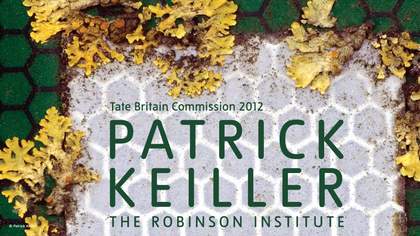Full Stop was made by spraying acrylic paint on to unprimed canvas. The black circle derives much of its character from marks left by the process: faint rectangular traces of weighted-down sheets of newspaper into which a circular template had been cut; a variety of blobs and smudges, all these outside the circle; and the moon-like irregularity of the circle’s blackness. It is a large work, 301.5 x 258 cm, and there are fold marks at regular intervals, two of which meet as a ‘T’ in the black, the paint fading a little along them as if the canvas has been folded after the paint was applied. It was made during the three months John Latham spent in New York in 1961, working at the Chelsea Hotel. I imagine the room in the Chelsea must have been quite big, though I may be wrong, and that the canvas was folded for transport. It arrived at Tate in 2005, rolled round a narrow cardboard tube, and is now supported on an aerolam panel. I don’t know whether Latham created it with the canvas laid flat on the floor, but if he did, this would mirror the method of his first process sculpture, made with creosote sprayed on a ceiling in the house of Clive Gregory and Anita Kohsen in Church Crookham, near Fleet in Hampshire, for a Halloween party in 1954.
Latham and Barbara Steveni lived in Fleet between 1951 and 1958. Clive Gregory (1890–1964) was an astronomer, the first director of the University of London observatory. In about 1950 he bought a dilapidated Edwardian mansion in Church Crookham: ‘With its bare dusty rooms, it was a ghostly echo of his boyhood home’, Melville, his son, the experimental psychologist Richard Gregory (1923–2010), wrote in 1996. Anita Kohsen (1925–1984) was an animal ethologist, with whom Clive shared an interest in the paranormal. In opposition to what they saw as a fragmented understanding of reality – the partial models of separate disciplines – they developed a unifying theory of the universe in which the elementary component is the ‘leastevent’, founded the Institute for the Study of Mental Images, of which Latham was an honorary founder member, and in 1959 published The O-Structure – An Introduction to Psychophysical Cosmology.
I was initially attracted to Full Stop by its astronomical aspect, when looking for works that might accompany the exhibition of a meteorite. I was drawn to it, also, as an emblem of ending.
I don’t know what Latham had in mind when he gave the work such an emphatic title; a full stop might merely indicate a pause between sentences, but such a large one does appear, potentially, final, even fatal, as striking a reminder of the possibility of termination as Thomas De Quincey’s ‘The Vision of Sudden Death’ in his essay The English Mail Coach. It recalled the punctuation and other graphic innovations of Laurence Sterne’s Tristram Shandy (see also Scott Myles’s Full Stop: The Life and Opinions of Tristram Shandy, Gentleman of 2008), my paperback copy of which bears Thomas Patch’s Caricature of Laurence Sterne and Death on its cover, Sterne’s writing having been undertaken in competition with his declining health. The idea of an ending, on the other hand, offers a compelling reason to go on living: to find out what happens in the end, even though we know that there is no end other than our own, at least not for an extremely long time, and that in history even intermediate ends, ends of sentences, are moments few and far between. Perhaps we are living through such a moment now. Either way, Full Stop strikes me as topical.
For a work so strongly identified with process, Full Stop is very suggestive of interpretations. The black disc/circle/ sphere/spot/dot is placed low on the canvas, and slightly to the right, as if it were moving, so as to resemble a rising moon, planet, or sun; an asteroid, or an enormous cannonball advancing obliquely towards the viewer. There is a fifteenth-century siege gun displayed at Edinburgh Castle that fired cannonballs 50 cm in diameter, though these are smaller than Latham’s black spot, and lack the latter’s smouldering corona and tiny moons, four of them forming an almost continuous line.
If some of these details resemble those of a solar eclipse, one might consider not so much the end as the beginning: the suggestion that life on Earth emerged as a result of the unusually large size of the Moon, of which solar eclipse is a reminder; or the beginning of the universe. As Marx pointed out: ‘Each extreme is its other extreme… North and South Poles are opposed determinations of one essence… real extremes would be Pole and non-Pole’; Full Stop and non-Full Stop.

